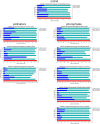Future distribution of the epiphytic leafless orchid (Dendrophylax lindenii), its pollinators and phorophytes evaluated using niche modelling and three different climate change projections
- PMID: 37709854
- PMCID: PMC10502118
- DOI: 10.1038/s41598-023-42573-5
Future distribution of the epiphytic leafless orchid (Dendrophylax lindenii), its pollinators and phorophytes evaluated using niche modelling and three different climate change projections
Abstract
The identification of future refugia for endangered species from the effects of global warming is crucial for improving their conservation. Because climate-driven shifts in ranges and local extinctions can result in a spatial mismatch with their symbiotic organisms, however, it is important to incorporate in niche modelling the ecological partners of the species studied. The aim of this study was to evaluate the effect of climate change on the distribution of suitable niches for the ghost orchid (Dendrophylax lindenii) and its phorophytes and pollinators. Thus, its five species of host trees and three pollen vectors were included in the analysis. Climatic preferences of all the species studied were evaluated. The modelling was based on three different climate change projections and four Shared Socio-economic Pathway trajectories. All the species analysed are characterized by narrow temperature tolerances, which with global warming are likely to result in local extinctions and range shifts. D. lindenii is likely to be subjected to a significant loss of suitable niches, but within a reduced geographical range, both host trees and pollen vectors will be available in the future. Future conservation of this orchid should focus on areas that are likely be suitable for it and its ecological partners.
© 2023. Springer Nature Limited.
Conflict of interest statement
The author declares no competing interests.
Figures




References
-
- Doadrio A. Climate change. A global overwiew. Anales De La Real Academia Nacional De Farmacia. 2011;77:1–29.
-
- Post E, et al. Global population dynamics and hot spots of response to climate change. Bioscience. 2009;59:489–497. doi: 10.1525/bio.2009.59.6.7. - DOI
MeSH terms
LinkOut - more resources
Full Text Sources
Medical
Research Materials

